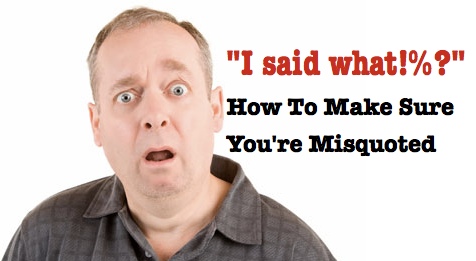A big resume, a big job–and a big scaredy cat when it comes to talking with journalists: this gentleman is bending my ear about how many times his CEO has been misquoted, mishandled and even hounded by the journalists at Business Insider, The Wall Street Journal, BusinessWeek, and so on. Each sip of the Moscow Mule he is nursing seems to bring out a fresh media insult.
I believed him—indeed, I was sure his chief executive had been misquoted a couple of times. Because after a few questions, I realized he had taken every step to ensure a journalist couldn’t get a straight story out of the comapny. If you’d like to claim bragging rights to a legacy of similar media misfortune, here’s how you do it:
Prepare for prime time agony
1) Don’t prep for your briefing. I mean, really don’t prepare. Here’s your checklist, and make sure your CEO follows this to the letter:
- Make sure you don’t have a ready backgrounder or even an executive bio you can forward to a journalist.
- Don’t waste time detailing three to five talking points in writing for your executive in writing—ever. Much less ask them to carry it on a card at conferences or trade shows.
- Don’t rehearse your executive with a media coach, tape her in a mock interview, or allow him or her to practice redirects.
Lack of preparation will get you respectably far, but to truly ensure a misquote from today’s wily, fast-moving and fully mobile business journalists, you have to go even further. My favorite suggestion is to:
2) Confuse your marketing collateral with the facts of your market. Facts are independently verifiable, and your marketing material should be a bit aspirational. Speaking of your marketing like it’s factual, and of the marketplace like it’s sort of fuzzy can make for some great misquote opportunities. Executives who work in business development scenarios often rehearse the business development presentation frequently–so nothing is simpler than to let them go in to a media briefing with this habit unbroken, and reap the results.
And finally, to nail the misquote,
3) Speak really fast in long, run-on sentences with compound structures that show off your doctoral-level understanding of Asian-Pacific nuclear industrial automation economics (or whatever your specialty is). Because most journalists are generalists, if you do this, you will leave them in the intellectual dust every time! By not setting up an executive with the bio and background of the (often young) journalist, you can make sure the executive speaks in his or her traditional expert role.
- By following this advice, you can bless your executive’s, or your, message with a breezy brilliance that carries, to a journalist’s undiscerning nose, the aroma of fresh-pressed baloney—and begs to be misunderstood.
Nailing the perfect quote the first time
On the other hand, many entrepreneurs and marketers covet a correct quote–like our clients. Chris at Ecologix, an environment water treatment firm we’re privileged to represent, shares with us that being in the Wall Street Journal makes their web traffic triple, and creates superior international inbound leads. So it’s worth it to get it right. These tips can help you avoid misquote situations completely AND make sure when your prospects read your coverage, they know to call.
- When you want to get your story across to media, don’t leave your million-person impression up to that moment when a writer from Fortune corners you in the elevator at the conference—prepare for it.
- Get your backgrounder, your message strategy, and your talking points not only on paper, but also in your head through rehearsal.
- Practice redirects. Get comfortable with the solid evidence that supports your position in the market. For every successful firm, it’s there, and it’s media-quote platinum.
Journalists really want to know about what’s moving your market and get your perspective on that—simply and clearly, with some evidence to back your position up like studies, tests, case studies, surveys, reference clients, and numbers. They appreciate a follow up email from you thanking them for their time, and restating those facts one more time, perhaps with a backgrounder and a bio attached or linked.
But if you do it that way, be warned: the fun of spinning misquote-victim-stories will all but disappear!
Want more fun and games with media?
Read more:
- How Would Olivia Pope Handle it? Interview Tips For CEOs
- For CEOs Only: 4 National Media Interview Must-Haves
And if you’re ready to get your own awesomeWall Street Journal interview—and more– give our integrated marketing team a shout.

